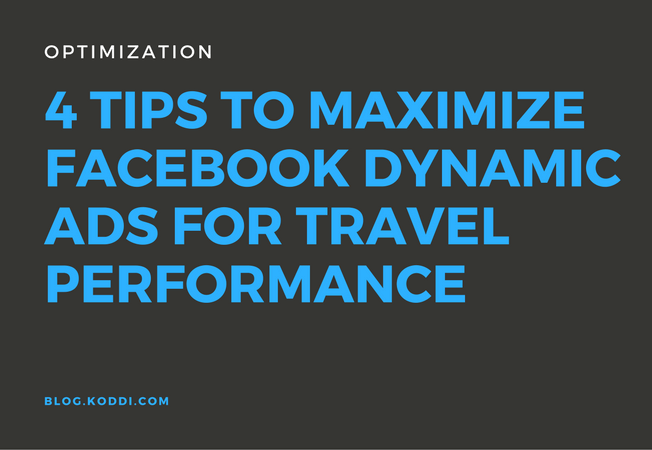Blog
4 Tips for Facebook's Dynamic Ads for Travel
In our previous blog post, we highlighted the main differences between Dynamic Ads for Travel (DAT) and Dynamic Product Ads (DPA). Put simply, Dynamic Ads for Travel (DAT) is essentially Dynamic Product Ads (DPA), but designed specifically to support travel brands (boy, do we love acronyms.) We have been running DAT campaigns from the earliest days of the program, and with participation steadily increasing, we figured this would be a good time for us to share some of the things that we’ve learned along the way.
Published February 20, 2017 by Connor VanDaveer

In our previous blog post, we highlighted the main differences between Dynamic Ads for Travel (DAT) and Dynamic Product Ads (DPA). Put simply, Dynamic Ads for Travel (DAT) is essentially Dynamic Product Ads (DPA), but designed specifically to support travel brands (boy, do we love acronyms.) When DPA, a primarily retail focused product, originally launched smart marketers recognized an opportunity to adapt the product to support travel brands. This caused two things to occur.
- Travel brands recognized that Facebook was no longer solely a branding opportunity, it was also a direct response channel.
- Facebook recognized the opportunity to expand their presence in the travel space and developed a product that better-supported travel brands (DAT).
We have been running DAT campaigns from the earliest days of the program, and with participation steadily increasing, we figured this would be a good time for us to share some of the things that we’ve learned along the way.
Give it a little time
As a general rule, you want to let new campaigns run without interruption for at least a couple of weeks. Facebook ads take time to build up momentum and paused or constantly rebooted ads often fall short of their campaign goals. Be patient with your Facebook campaigns, and you’ll get a better understanding of what is possible
Cast a wide net
Facebook comes with an extremely robust set targeting tools and it can be very tempting to set up hyper focused audiences from the get go. While there is a place for getting granular, you don’t want to limit yourself too much. We have found that in terms of setting up target audiences, less is more. Getting too specific and granular too early can be a significant hindrance to achieving maximum conversion volume and return performance. There is definitely a case for more granular targeting and this can unlock great gains over time. Going too narrow too soon can cause you to both underperform and can result in low volumes where you’re missing out on bookings that you’d be happy to have otherwise.
Always be testing
After your initial campaign is launched and your baselines are set, it is time to start testing. There are a lot of levers you can pull. Start by editing your content and images to refine your ad. Use A/B tests and automated optimization to find out which audiences perform to which messaging. Once you’re confident in those elements you can manipulate the audience elements to really hone in. During this time, be sure to structure campaigns in a way that doesn’t impact your overall business; we’ve seen many cases where a high performing evergreen campaign is put at risk due to a suboptimal testing strategy.
Set it, don’t forget it
More so than most publishers, maximizing performance on Facebook can be a constant game of cat and mouse. There are two major factors that influence your position: how much you’re willing to pay and how users are engaging with your content. It is important to note that Facebook is a second price auction, meaning the highest bidder only pays a small increment more than the second highest bidder. This shouldn’t lull you into a false sense of security, though. We’re seeing a lot of competition for the same users. Especially in scenrios where there isn’t a lot of difference between offers constant optimization is required to ensure that ads maintain the proper position and a profitable return. Ultimately, running a successful Facebook campaign is a continues cycle of refinement. Be patient when you first launch and then tweak often.
Bringing it together
DAT is a powerful direct response channel. We have seen conversion rates range from low single percentages into double digits with the right mix. We’ve seen a growth in our partner’s investment, and we expect this positive trend to continue. Facebook continues to offer more advanced options that we can use to augment performance across channels. It allows us to get more strategic than many other channels which has made it an important piece of the digital marketing mix for many brands. It wasn’t long ago that metasearch was the unproven, untested and uncertain investment. With that in mind, I can only wonder what Facebook has in store now that results are trending upward. We expect to see a more full-funnel approach with the ability to reach out to consumers that are not yet familiar with your brand or fall outside of your cookie window.
You may be interested in
GET IN TOUCH
Ready to get started?
Don’t let your brand get lost in the noise. Partner with Koddi to unlock the power of commerce media and transform the way you engage with your customers. Our team of experts is here to help you navigate complexities and develop a strategy that drives results — no matter what industry – in as little as 45 days.